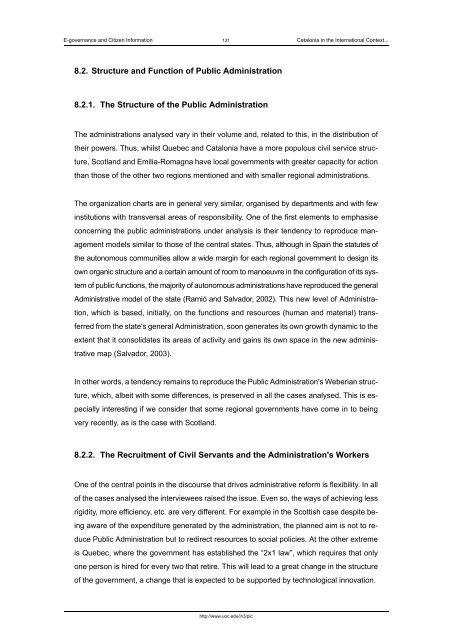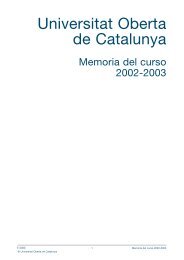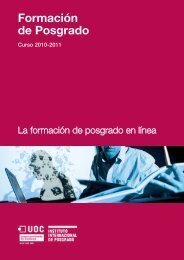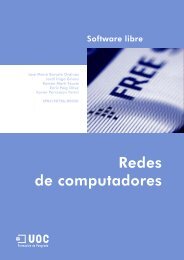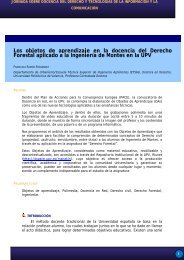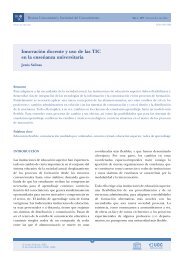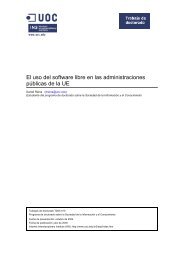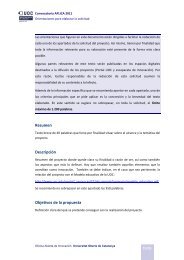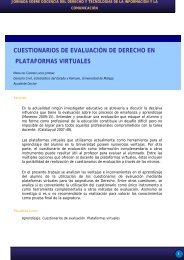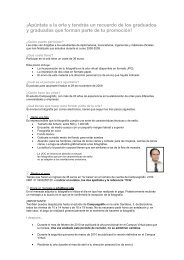e-governance and citizen information - Universitat Oberta de ...
e-governance and citizen information - Universitat Oberta de ...
e-governance and citizen information - Universitat Oberta de ...
Create successful ePaper yourself
Turn your PDF publications into a flip-book with our unique Google optimized e-Paper software.
E-<strong>governance</strong> <strong>and</strong> Citizen Information 131 Catalonia in the International Context...8.2. Structure <strong>and</strong> Function of Public Administration8.2.1. The Structure of the Public AdministrationThe administrations analysed vary in their volume <strong>and</strong>, related to this, in the distribution oftheir powers. Thus, whilst Quebec <strong>and</strong> Catalonia have a more populous civil service structure,Scotl<strong>and</strong> <strong>and</strong> Emilia-Romagna have local governments with greater capacity for actionthan those of the other two regions mentioned <strong>and</strong> with smaller regional administrations.The organization charts are in general very similar, organised by <strong>de</strong>partments <strong>and</strong> with fewinstitutions with transversal areas of responsibility. One of the first elements to emphasiseconcerning the public administrations un<strong>de</strong>r analysis is their ten<strong>de</strong>ncy to reproduce managementmo<strong>de</strong>ls similar to those of the central states. Thus, although in Spain the statutes ofthe autonomous communities allow a wi<strong>de</strong> margin for each regional government to <strong>de</strong>sign itsown organic structure <strong>and</strong> a certain amount of room to manoeuvre in the configuration of its systemof public functions, the majority of autonomous administrations have reproduced the generalAdministrative mo<strong>de</strong>l of the state (Ramió <strong>and</strong> Salvador, 2002). This new level of Administration,which is based, initially, on the functions <strong>and</strong> resources (human <strong>and</strong> material) transferredfrom the state's general Administration, soon generates its own growth dynamic to theextent that it consolidates its areas of activity <strong>and</strong> gains its own space in the new administrativemap (Salvador, 2003).In other words, a ten<strong>de</strong>ncy remains to reproduce the Public Administration's Weberian structure,which, albeit with some differences, is preserved in all the cases analysed. This is especiallyinteresting if we consi<strong>de</strong>r that some regional governments have come in to beingvery recently, as is the case with Scotl<strong>and</strong>.8.2.2. The Recruitment of Civil Servants <strong>and</strong> the Administration's WorkersOne of the central points in the discourse that drives administrative reform is flexibility. In allof the cases analysed the interviewees raised the issue. Even so, the ways of achieving lessrigidity, more efficiency, etc. are very different. For example in the Scottish case <strong>de</strong>spite beingaware of the expenditure generated by the administration, the planned aim is not to reducePublic Administration but to redirect resources to social policies. At the other extremeis Quebec, where the government has established the “2x1 law”, which requires that onlyone person is hired for every two that retire. This will lead to a great change in the structureof the government, a change that is expected to be supported by technological innovation.http://www.uoc.edu/in3/pic


